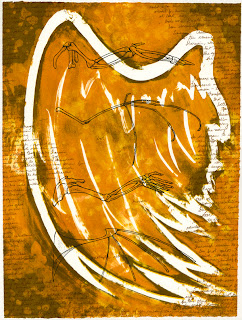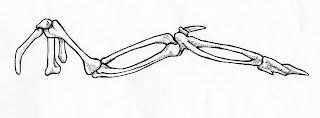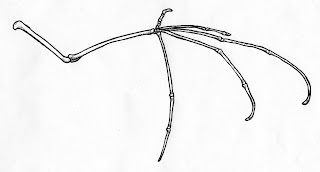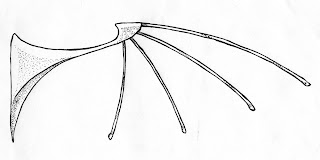It ain't no sin to take off your skin and dance around in your bones. Or to study the bones of other creatures. That's fun.
Sunday, March 27, 2011
Skeletal Blogroll
If you look to your right, you'll see I've added a blogroll. Woo! The blogs listed are a mix of archaeology, palaeontology and zoology, and they're mostly not all-bones-all-the-time, but they do have a goodly amount of posts relating to bones. If I've missed any, please do let me know (you can leave a comment on this post, for example) and I'll check them out.
Saturday, March 26, 2011
Bone Art: The Evolution of Flight
A few years ago, when I was still in art school, I made a lithograph titled "The Evolution of Flight." It ties in to some stories and comics and books and artefacts I've been working on which will all come together in something bigger once I figure out what shape I want it to take.
But anyway, what's relevant for this blog is that I used bones in it. The print -- as you can see from the image -- is multiple layers of stuff. For those interested, I started with three runs from a litho stone, altering it each time with etching and sanding (that's the wing shape that dominates the image from far away). Then I added two separate runs from aluminum photoplates, made from my own drawings (or handwriting, in the case of the brown layer). One of those plates is a sort of comparative anatomy diagram, which came to mind when I was writing up the book review in my last post.
The image shows four skeletal limbs. The first is a bird:
The next is bat:
Then, of course, human, because this is the evolution of human flight:
And the final one is not from an animal but a flying machine (of my own silly invention) called a pterothopter.
In retrospect, I should also have included a pterosaur wing, though the pterpthopter is acutally named for Pteropus, the genus of bats called "flying foxes" and not for the pterosaurs. Still, it would have been a good thing to have.
The handwriting, incidentally, is bits of a story about a made scientist character who decided to create flying humans. She intended to do so through a combination of selective breeding and prosthetic surgery, but eventually gave up to work on flying machines with human pilots instead (and her neighbours breathed a sigh of relief).
But anyway, what's relevant for this blog is that I used bones in it. The print -- as you can see from the image -- is multiple layers of stuff. For those interested, I started with three runs from a litho stone, altering it each time with etching and sanding (that's the wing shape that dominates the image from far away). Then I added two separate runs from aluminum photoplates, made from my own drawings (or handwriting, in the case of the brown layer). One of those plates is a sort of comparative anatomy diagram, which came to mind when I was writing up the book review in my last post.
The image shows four skeletal limbs. The first is a bird:
The next is bat:
Then, of course, human, because this is the evolution of human flight:
And the final one is not from an animal but a flying machine (of my own silly invention) called a pterothopter.
In retrospect, I should also have included a pterosaur wing, though the pterpthopter is acutally named for Pteropus, the genus of bats called "flying foxes" and not for the pterosaurs. Still, it would have been a good thing to have.
The handwriting, incidentally, is bits of a story about a made scientist character who decided to create flying humans. She intended to do so through a combination of selective breeding and prosthetic surgery, but eventually gave up to work on flying machines with human pilots instead (and her neighbours breathed a sigh of relief).
Wednesday, March 16, 2011
Book Review: Comparative Skeletal Anatomy

Comparative Skeletal Anatomy: A Photographic Atlas for Medical Examiners, Coroners, Forensic Anthropologists, and Archaeologists by Bradley J. Abrams and Pamela J. Crabtree. Totowa, NJ: Humana Press, 2008.
I have a confession to make: when I'm passionately interested in a particular subject, I treat my books on the subject as more of a collection than a library. And what I mean by that is that I have the strong, sometimes irresistible urge to buy every book on that subject, and not just the good ones. And so it is with bone books. Even when a book gets terrible reviews, I want to buy it for my collection. The good side of this tendency is that I'm never really disappointed by a lousy book--it's still a good piece for the collection. The bad side is that I waste money on books that aren't really useful.
By now you're probably expecting me to say how terrible this book is, and I'll get to that, but I should point out that it's not all bad, and there probably is an audience for whom Comparative Skeletal Anatomy will be useful. I can certainly imagine situations where photographs directly comparing human and animal bones would be handy to have. It's just too bad the photographs aren't better.
So, OK, reasons why you probably won't want to buy this book unless you collect books about bones (as opposed to having a library of carefully selected volumes):
- The photographs are terrible. I'd like to be able to say that a good deal of the problems (flatness, darkness, poor reproduction) are the fault of the book's production values and not of the photographer, but a good photographer should be able to get enough depth of field so that all parts of a bone are in sharp focus. I could overlook out-of-focus areas on something like a skull, which has considerable volume, but most elements only need a few inches. In a studio, with the right lens, there shouldn't be focus problems.
- The text is not all that useful. In a book like this, there should be arrows pointing out key similarities and differences to look for, summarized below each photograph. And the essays included are either not detailed enough, or don't seem to relate directly to the purpose of the photographs.
- The comparisons are sometimes a bit odd. While most of the photographs compare the same element between human and an animal, sometimes they show different sides (a left compared to a right, for example), sometimes the orientation of the bone is different (side view of one compared with front view of another, say), and sometimes an element is left out altogether. Some of this is no doubt due to availability of specimens, but still.
I'm going to stop pointing out the negatives here, because I'm starting to feel mean. I don't regret buying Comparative Skeletal Anatomy--where else am I going to find a comparison of human and duck bones?--but I can't recommend it unless you're a collector like me. Or unless it's the only book you can find on the subject.
Subscribe to:
Posts (Atom)




